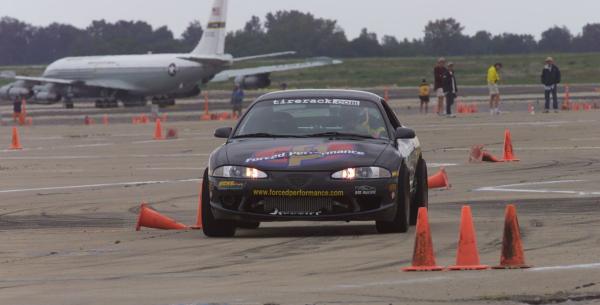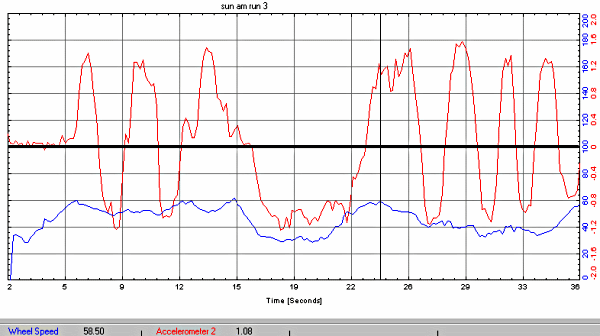What Is Autocross?
Autocross, called by the SCCA "Solo2" for bizarre historical reasons, is the oddball bastard child of autosports.
If motorsports were alpine skiing, then road racing would be the downhill - fast and glamorous. The sport that gets all the TV coverage, featured in all the James Bond films, and takes the most money to be competitive in.
Autocross is more like the slalom - not the Grand Slalom, mind you - but the plane-Jane slalom. Less fast. Less dramatic. But certainly not lacking in skill and ability in order to be successful at it.
The basic concept is simple: take a large paved area. Describe on its surface, a race course, marked off with traffic cones and chalk lines. Place a timer at the start and finish, and one car at a time, drive through as fast as you possibly can. Hit a cone, and get two seconds added to your time.
The track is never the same twice from event to event. There are no practice runs. We run rain or shine.
This is very similar to "parking lot racing" which is done in some form or another all over the world, but on much larger sites, typically airports. Old B-52 staging aprons make particularly good sites, as they are HUGE and made of high-quality concrete.

The events we attend follow one of two formats:
In "standard" Solo2, you get three attempts at the course. Your fastest time of the three is what is scored. On two-day events (as most are) a completely different course is set up on the second day, and the overall time for the event is the best time from each day, added together.
In Formula One terms, an autocross is like bringing your team to a track (which was completely torn down and rebuilt from the last time you were here) you get three qualifying laps, from standing starts (each one!) and on cold tires (no tire warmers allowed). The next day, you do the same thing, but in the opposite direction, and then the track owner rips up the track and starts building a new one. Six runs total, best one each day counts.
This is the South Course from Nationals 2001. The large, black oblong with a dot next to it, just above the "Grid B" lettering, represents the bus used as a timing and control tower, roughly to scale with the rest of the course. This is no "parking lot race"!
The second format is called "ProSolo". Unlike standard autocross, it features head-to-head competition, and the course does not change during the event (although it does change from event to event) It also is run as a points series, much like Formula One is.
A typical ProSolo course looks like this:
The start line uses an NHRA-style "christmas tree" light system and starts are standing starts - just like drag racing.
An event weekend typically works as follows:
On Friday, there is a session of practice starts, where the cars use the same start as they will during the event, but only run out 60 feet. Practice starts are not scored, but times are announced, making for bragging rights at least.
Three competition heats are then run: two on Saturday, and one on Sunday morning. Each heat consists of four runs, two on each side. You do a run on one side, then immediately follow with a run on the other, go back to grid to cool down, then repeat, alternating sides. Your time of record consists of your best time on each side, added together. So on a full weekend, you will get twelve runs; six per side. Fastest total time per class wins.
But wait, there's more: The class winners are ranked in order of their margins of victory over the second place cars, and then the second place (on down) cars are also ranked in inverse margin from their class leaders. The top 32 cars according to this ranking qualify for "The Show" also known as "The Challenge". In the Challenge, you get a dial-in time based on the time your class leader used to win the class. Differentials are computed, and the cars from the slower classes are given that much of a head start on the tree. This is now a single-elimination ladder (one run on each side, head-to-head) proceeding until a winner has been determined.
And for certain special classes (mine included) there is another Challenge, run in parallel.
So on a given weekend, there are three sub-events you can win: 1) your class 2) the main Challenge 3) The Honda Street Challenge.
Points are scored on all three sub-events, and end-of-season prizes and money awarded on how it all turns out.
This all makes for a sport that is very different from any other style of motorsport. On the whole, it is less expensive and less dangerous than other forms, as there is very little chance of crashing into something hard, and speeds tend to be slower. On the other hand, it demands a very high level of aggressiveness and driver precision - you have to be instantly fast, and everything must go right immediately. There is just no margin for error. Races are won and lost by thousandths of a second, and the mental pressure can be enormous.
For those of you with some road race data scraping experience, here is a data trace taken from a ProSolo run:

Red is lateral G, blue is wheel speed. Note that the run is 35 seconds long, and contains 16 major elements. Drinking from the fire hose indeed!
Of the two formats, Far North Racing specializes in ProSolo, primarily because it is the more "Pro" of the events. It is a series competition, rather than a bunch of one-off events, and the "Pro" nature tends to attract better and tougher competition. Plus the head-to-head nature makes for a better driving and spectator experience. We do compete at "amateur" events as well, but not with the same degree of intensity. We consider ourselves a ProSolo team.
2010 Comment: Add into this a perverse lack of promotion from the Secret Car Club of America (who somehow managed to miss the whole Import Craze, notwithstanding being filled with some of the highest-performing Imports ever raced....)
